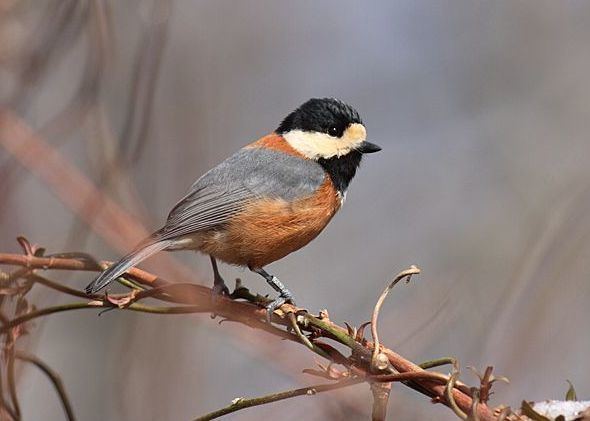Order Passeriformes Higher classification Cyanistes | Phylum Chordata Family Paridae Rank Species | |
 | ||
Similar Japanese tit, Bird, Japanese pygmy woodpecker, Daurian redstart, Meadow bunting | ||
Varied tit birds of japan 6 yamagara
The varied tit (Sittiparus varius) is a perching bird from the tit family, Paridae. It occurs in eastern Asia in Japan, Korea, and locally in northeastern China (southern Liaoning) and extreme southeastern Russia (southern Kurile Islands).
Contents
- Varied tit birds of japan 6 yamagara
- Varied tit poecile varius varius
- Description
- Systematics
- In culture
- References
Varied tit poecile varius varius
Description
The varied tit is 12–14 cm (4.7–5.5 in) long and weighs 16–18 g (0.56–0.63 oz). The wing length is 6.0–7.8 cm (2.4–3.1 in). In the nominate race S. v. varius the crown, the bill, the throat, the upper breast and the nape are black. Forehead, face, and cheeks are white. Back, wings, and tail are bluish grey. Mantle, lower breast, belly and undertail coverts are chestnut coloured. From the crown to the nape runs a thin white central line. The feet are dark grey.
Its habitat consists of open mixed forests, in particular with the Japanese Castanopsis species Castanopsis cuspidata and Japanese larch, coniferous forests with Japanese yews, Cryptomeria (sugi), and pines as well as bamboo forests at mountain slopes and in river valleys.
The varied tit eats a mixed diet consisting of seeds and insects, namely caterpillars.
Its call consists of tiny tones which sounds like tzu….tzu….tzu…
Systematics
Until the end of the twentieth century the varied tit was usually placed along with most of the other member of the tit family in the genus Parus. In 2005 the report of a molecular phylogenetic study that examined mitochondrial DNA sequences from members of the tit family, recommended including the varied tit along with around fifteen other species in the resurrected genus Poecile. The authors of a 2013 study that analysed both mitochondrial and nuclear sequences, suggested splitting Poecile and placing the varied tit and its sister taxon, the white-fronted tit in their own genus Sittiparus. This proposal was adopted by the International Ornithologists' Union.
Owston's tit (Sittiparus owstoni), the Iriomote tit (Sittiparus olivaceus) and the chestnut-bellied tit (Sittiparus castaneoventris) were formerly considered as subspecies of the varied tit, but were promoted to species status following the publication of a phylogenetic study in 2014.
A number of subspecies have been described, of which one has become extinct in the 20th century:
In culture
In Japan varied tits have been used in a kind of show called "omikujihiki" to draw fortune telling-slips (omikuji). Using a small model Shinto shrine the birds will deposit a coin, ring a bell, open the door, remove a fortune telling slip and return with it. They may also use their beaks to open it by cutting a string or tape.
